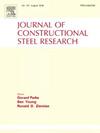Self-centering devices with damage-free, high energy-dissipation and variable stiffness characterization during earthquakes
IF 4
2区 工程技术
Q1 CONSTRUCTION & BUILDING TECHNOLOGY
引用次数: 0
Abstract
Over the last few years, significant progress has been made in innovative low-damage structures excited by strong earthquakes, thanks to the development of self-centering energy-dissipation devices (SCEDs). However, SCEDs still face several challenges: they require high prestressing forces or complex configuration, they have constant post-yield stiffness, which makes them difficult to achieve a reasonable balance between internal forces and displacement, and they have insufficient recoverability, such as energy-dissipation components have to be replaced after an earthquake. This study presents a novel SCED with springs, lead extrusion dampers, and a deformation-amplified system (SL-SCEDs) to address these inadequacies. The device is characterized by low damage, variable stiffness, high energy dissipation, and low prestressing force. The concept and working mechanism were illustrated. An analytical model was developed to quantify the hysteretic behavior. A numerical parametric study was subsequently conducted. To evaluate the effectiveness of SL-SCEDs, time history analyses were carried out based on solid piers, spherical steel bearings, friction pendulum bearing combined with circular steel dampers, and conventional SCEDs were selected for comparison. The results show that SL-SCEDs can effectively reduce the maximum bearing displacement by 44 %, and the residual displacement of SL-SCEDs is almost negligible, which is the best performance among the four earthquake-resistant systems. Additionally, the maximum shearing force of the pier equipped with SL-SCEDs is lower than traditional SCEDs (2 % ∼ 5 %) and slightly higher than spherical steel bearings (1 % ∼ 10 %). The anticipated performance objectives of SL-SCEDs are realized, demonstrating a promising pathway toward resilient structures.
求助全文
约1分钟内获得全文
求助全文
来源期刊

Journal of Constructional Steel Research
工程技术-工程:土木
CiteScore
7.90
自引率
19.50%
发文量
550
审稿时长
46 days
期刊介绍:
The Journal of Constructional Steel Research provides an international forum for the presentation and discussion of the latest developments in structural steel research and their applications. It is aimed not only at researchers but also at those likely to be most affected by research results, i.e. designers and fabricators. Original papers of a high standard dealing with all aspects of steel research including theoretical and experimental research on elements, assemblages, connection and material properties are considered for publication.
 求助内容:
求助内容: 应助结果提醒方式:
应助结果提醒方式:


